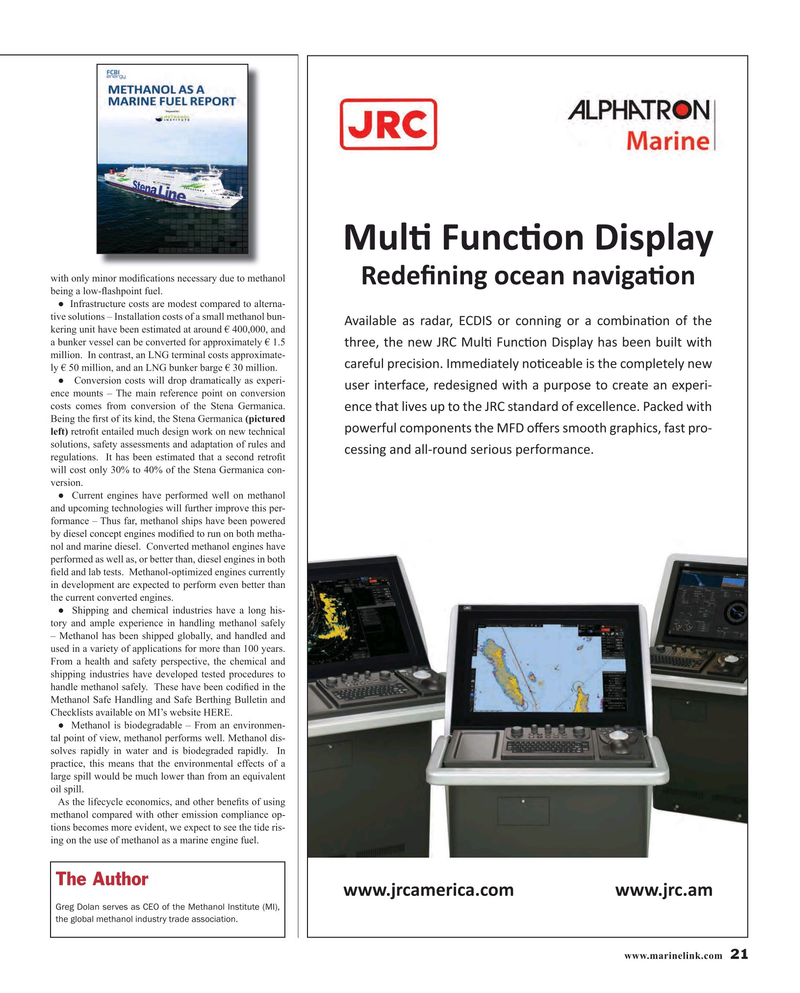
Page 21: of Maritime Reporter Magazine (March 2016)
Green Marine Technology
Read this page in Pdf, Flash or Html5 edition of March 2016 Maritime Reporter Magazine
D?uO&?YÐOŽYs?ÐuA?
with only minor modi? cations necessary due to methanol
ZGEGIYsYOŽÐGAYYA|sOAOŽY being a low-? ashpoint fuel.
? Infrastructure costs are modest compared to alterna- tive solutions – Installation costs of a small methanol bun- |AsuAduGA??AEA??/^Ž?ÐŽYYsYOŽ?AÐŽwdsYAOŽYŽIlSG kering unit have been estimated at around € 400,000, and a bunker vessel can be converted for approximately € 1.5 lS?GG?lSGYG?:ZD?uO&?YÐOŽYs?ÐuA?SA?dGGYd?sul?slS million. In contrast, an LNG terminal costs approximate-
ÐA?GI?uÐ?GÐs?sŽY?/wwGEsAlGu?YŽOÐGAduGs?lSGÐŽwÐuGlGu?YG?
ly € 50 million, and an LNG bunker barge € 30 million.
? Conversion costs will drop dramatically as experi- ??G?sYlG?IAÐG??GEG?sOYGE?slSAÐ??ÐŽ?GlŽÐ?GAlGAYG?ÐG?s- ence mounts – The main reference point on conversion costs comes from conversion of the Stena Germanica.
GYÐGlSAlus|G??ÐlŽlSG:Z?lAYEA?EŽIG?ÐGuuGYÐG?WAÐUGE?slS
Being the ? rst of its kind, the Stena Germanica (pictured
ÐŽ?G?I?uÐŽwÐŽYGYl?lSGD&ŽiG???wŽŽlSO?AÐSsÐ??IA?lÐ?Ž- left) retro? t entailed much design work on new technical solutions, safety assessments and adaptation of rules and
ÐG??sYOAYEAuu??Ž?YE?G?sŽ??ÐG?IŽ?wAYÐG?
regulations. It has been estimated that a second retro? t will cost only 30% to 40% of the Stena Germanica con- version.
? Current engines have performed well on methanol and upcoming technologies will further improve this per- formance – Thus far, methanol ships have been powered by diesel concept engines modi? ed to run on both metha- nol and marine diesel. Converted methanol engines have performed as well as, or better than, diesel engines in both ? eld and lab tests. Methanol-optimized engines currently in development are expected to perform even better than the current converted engines.
? Shipping and chemical industries have a long his- tory and ample experience in handling methanol safely – Methanol has been shipped globally, and handled and used in a variety of applications for more than 100 years.
From a health and safety perspective, the chemical and shipping industries have developed tested procedures to handle methanol safely. These have been codi? ed in the
Methanol Safe Handling and Safe Berthing Bulletin and
Checklists available on MI’s website HERE.
? Methanol is biodegradable – From an environmen- tal point of view, methanol performs well. Methanol dis- solves rapidly in water and is biodegraded rapidly. In practice, this means that the environmental effects of a large spill would be much lower than from an equivalent oil spill.
As the lifecycle economics, and other bene? ts of using methanol compared with other emission compliance op- tions becomes more evident, we expect to see the tide ris- ing on the use of methanol as a marine engine fuel.
The Author www.jrcamerica.com www.jrc.am
Greg Dolan serves as CEO of the Methanol Institute (MI), the global methanol industry trade association.
www.marinelink.com 21
MR #3 (18-25).indd 21 3/2/2016 11:09:43 AM

 20
20

 22
22
